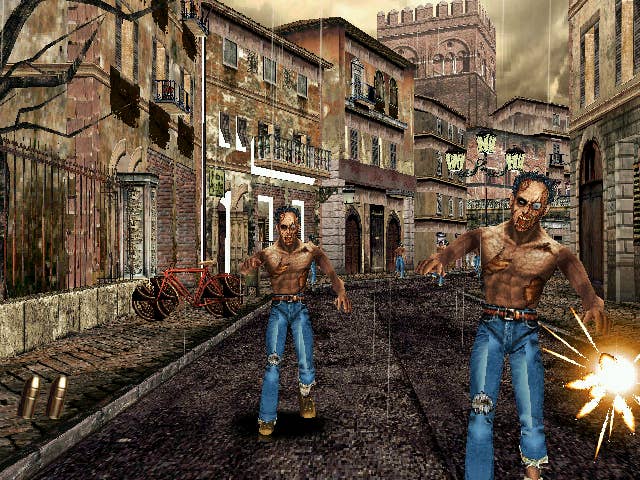Bring back incredible video game peripherals, you cowards
What do slot machines, party games, and arcades all have in common? The best thing about them is dying.
A few days ago, I had a quiet revelation. Or perhaps revelation is a bit strong. You’re familiar with the feeling, I’m sure – I felt something I already knew in the very core of my being crystallize into a much more readily articulable opinion. That is: I miss dedicated gaming hardware.
Now, obviously, we still have ‘dedicated gaming hardware’ of a certain type. We have consoles, specialist PCs, retro throwbacks, and so on. But I’m really talking about something a little different; where we had highly game-specific add-ons, extras, or even entire machines designed to deliver a distinct experience for a particular game.
I’m talking about stuff like light guns and dance mats. I’m talking about arcade machines that deployed mega-specific hardware, from Street Fighter’s infamously s**t and quickly-dropped hand-ruining pressure-sensitive buttons, to the Game Boy Camera. I’m talking about Guitar Hero and Rock Band. I’m talking about those stupid GameCube bongos.
This thought was formulated in a curious place: Las Vegas. I like gambling, and though my heart is always with the tables, I do like a slot machine. I especially like a well-designed licensed machine that hammers the senses with waves of nostalgia for some film or TV show. I like hunting for new machines based on franchises I have an affinity for, as they’re honestly not very common at home in the UK.
These nostalgia vehicles are even crossing into gaming now - in this latest trip, I discovered slots based on Resident Evil and, unbelievably, House of the Dead. The latter one is particularly amusing, as I’ve still not seen a House of the Dead: Scarlet Dawn shooter machine in the wild outside of Japan, but the gambling spin-off can now be found in pretty much every major Vegas casino.

Anyway. I like a licensed machine, even though supposedly the pay-out is marginally worse on them to account for licensing fees. These machines are often a sublimely evil work of game design, manufacturing surges of dopamine that are of course intended to lower your inhibitions and keep you gambling until you’ve got nothing left. It’s evil s**t, really dangerous, and needs to be heavily regulated by governments - though as somebody who has control and doesn’t struggle to walk away, I love it. For me, it isn’t as much about winning (though that’s always nice) as it is the machine popping off when it hits a feature. I love the spectacle of it, as I do in any well-designed game.
This recent trip to Vegas was my first time back in four years. That city changes at a ridiculous pace, but I noticed one interesting and sad change: a lot of the most original, intricate slots are disappearing. This has undoubtedly been happening for a while - but this trip was the one where I really noticed. It was noticable not just in the big main strip hotels, but also in the smaller setups.
The functionality is still there, to be fair. There’s a really good new Willy Wonka machine that’ll get the Oompa Loompa song stuck in your head. But it’s all digitally-driven now. Areas of machines that once would’ve been uniquely shaped, molded, and engineered are now simply giant screens. A machine that at one point would’ve had the grand spectacle of a great big wheel above the player that lit up and spun for a feature is now just… a giant screen that displays a big wheel.
In fact, the casino floors are generally quite homogenous now. You’ll see the same five or six ‘designs’ of machine, some of which are made by normal gaming stalwarts like Sega and Konami, deployed with different software running on them. Those House of the Dead and Resident Evil slots I mentioned earlier? They both ran on identical cabinets. Machines with truly original hardware, where the physical cabinet and game intersect and exist in symbiosis, are few and far between. The ones left are, generally speaking, old and slowly decaying. Soon they’ll be gone completely.
The same is true in arcades. We don’t get many new Light Gun games now, but those that we do like the Halo and Jurassic Park arcade games from Raw Thrills follow a strict template which makes the machines relatively uniform. ‘Video Pinball’ is now not just something you play on your TV to replicate the arcade experience, but a real category of pinball machine where all that tactile joy is replaced by a bloody screen showing the same action.

And, of course, the same is true in home video games. We went through an age where plastic tat was so ubiquitous that I couldn’t wait for the trend kicked off by Guitar Hero to be over - but now it is, I lament its passing - and the death of other long-standing peripherals that bubble bursting took with it.
We don’t get light gun games any more. Even Nintendo, king of the random slightly-crap accessory, has really cooled its jets lately. We got one really good one in Ring Fit Adventure and a slightly half-baked idea in Labo, but it really does feel like that era has ended. Most shockingly, Harmonix is still releasing Rock Band DLC pretty much every single week, but it’s literally impossible to buy new Rock Band hardware.
There is one exception, of course. We do have one expensive piece of specific gaming hardware around: virtual reality. But I don’t see these headsets in that way, honestly. They’re more like consoles and platforms in their own right. There’s none of that glorious specificity that I loved about certain accessories as a kid. I miss that. I don’t want a new Time Crisis inside VR; I want a real new Time Crisis, with a bloody GunCon. I don’t want another damn sit-in fixed gun light gun shooter in the arcades - I want something outlandish and weird, like Konami’s ducking-and-diving Police 24/7.
Maybe I’m just an old man yelling at a cloud. But I do feel like some sense of art and creativity has been lost in the homogenous nature of gaming hardware today - be that in arcades, casinos, or in our living rooms. I really hope, in the years to come, we can get some of that back.

